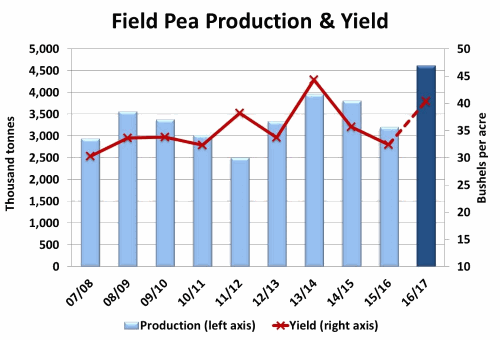What Did the StatsCan Production Report Have to Say?
In late August, StatsCan released its first production estimates for 2016 crops, based on a survey of farmers done in late July and early August. While most traders, analysts and farmers don’t take the numbers as gospel truth, they’re a good starting point for making revisions. At the same time, the numbers are also weighed against provincial yield estimates from Alberta and Saskatchewan Ag to make sure they’re reasonable.
For peas, StatsCan estimated a 4.6 million tonne crop for 2016, 1.4 million tonnes (44%) larger than last year. That was based on a yield of 40.4 bu/acre, 8 bushels more than last year and about 10% above the 5-year average of 36.8 bu/acre. Even though it’s a record crop, the final production number could end up even larger. For one thing, Alberta Ag’s latest yield estimate is 44.2 bu/acre and Saskatchewan is at 42 bu/acre. More importantly though, the StatsCan results have a track record of understating the crop. In each of the last five years, the final production estimate has been well above the August report, with an average of 385,000 tonnes. So don’t be surprised to see larger production numbers in later reports.

Even though there’s a big boost in the 2016 crop, it doesn’t apply evenly across the main types. Based on earlier acreage breakdowns, it looks like nearly all of the production increase is in yellow peas, with greens up only marginally. This means the larger supplies are mostly weighing on the yellow pea side of the market, while greens have regained their premium position.
There’s still a lot of uncertainty about the size of the lentil crop, even after StatsCan issued its production estimate of 3.2 million tonnes. The StatsCan yield number was 1,326 pounds per acre (22.1 bushels) and that’s well above the Sask Ag yield of 1,200 pounds. Even though the StatsCan estimate is sharply lower than ideas earlier in the summer, the 2016 crop would still be a new record by a wide margin. Red lentil acres had expanded more than greens, so more of the production increase is seen there.
On the surface, this lentil crop would still be large enough to meet a big increase in export business, but there are other considerations. For lentils, the quality of the 2016 crop is almost overshadowing the quantity and the longer the harvest is delayed, the greater the concerns. Those issues kept bids supported for a while, especially for #1 and #2 quality, but discounts for lower grades have expanded.
The 2016 chickpea crop was estimated at roughly 115,000 tonnes, once Alberta acreage is factored in. That’s 27% more than last year, but far below earlier expectations and the market’s needs. Because chickpeas are harvested later, there’s more uncertainty about this crop estimate, so some surprises in the final outcome are likely. Even with a large increase, global supplies are so tight that these Canadian chickpeas will be easily absorbed into the export market.
For dry beans, the StatsCan data needs a little tweaking to fill in the blanks, but it looks like the 2016 crop will be at least 10% smaller than last year. Pinto beans are one type that could see an increase while other classes will mostly be well below last year. The same scenario is playing out in the US bean crop and this reduced production is causing bids to rise.
Even though the StatsCan production numbers are still open to debate, most of the market’s focus is now shifting to the demand side of the ledger. Larger crops will mostly be absorbed by heavier demand, but there are still sizable question marks about export potential in the second half of 2016/17.
Source : Albertapulse